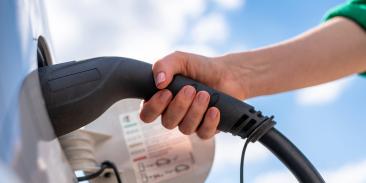Setting the record straight: EPA has ample authority to protect us from carbon pollution
(This post was co-authored by Tomas Carbonell and Peter Heisler.)
Even though they account for 40 percent of U.S. emissions of harmful carbon pollution, fossil fuel-fired power plants are currently subject to no national limits on the amount of such pollution they emit. Drawing on the same Clean Air Act tools it has previously used to regulate other pollutants, the U.S. Environmental Protection Agency (EPA) is working to put in place common-sense standards for carbon pollution from new and existing power plants.
Recently, a group of state attorneys general[1] issued a White Paper challenging EPA’s authority to establish minimum emission performance standards for carbon pollution from existing power plants under Section 111(d) of the Clean Air Act, and to issue rigorous standards for new power plants that are based on advanced technologies such as carbon capture and storage. This attack on EPA’s well-established authority to administer the Clean Air Act is legally unfounded and a misguided attempt to obstruct urgently-needed and long-delayed limits on carbon pollution from our nation’s largest source.
Background
On June 25, 2013, President Obama called on EPA to exercise well-established authority under Section 111 of the Clean Air Act to establish common-sense limits on carbon pollution from both new and existing power plants. A proposed rule that would implement the nation’s first limits on carbon pollution for new plants under Section 111(b) is due to be released for public comment by September 20th. At the same time, EPA has been reaching out to a diverse group of stakeholders—including state policy makers and energy regulators, industry, and the environmental community—to seek input as they begin to develop proposed emission guidelines for existing power plants under Section 111(d). These emission guidelines will set out the environmental performance criteria that state plans to implement Carbon Pollution Standards for existing power plants must meet to satisfy the Clean Air Act.
EPA’s authority to establish environmental performance criteria for state plans under Section 111(d) is firmly grounded in the statute and no longer open to legal attack.
The argument that Section 111(d) authorizes EPA to issue only procedural requirements for state plans to implement emission standards for existing pollution sources is not new; it revives an industry interpretation of the Act that EPA considered and rejected in 1975, when the Agency first undertook a rulemaking to implement Section 111(d). There, EPA carefully analyzed the language, purpose and legislative history of Section 111(d),[2] and concluded that all of these authorities supported its responsibility to ensure that states plans meet environmental performance targets. The Agency has consistently adhered to this interpretation for almost 40 years while putting in place Section 111(d) emission guidelines for a number of major sources of harmful air pollution including municipal solid waste landfills, municipal waste combustors, and sulfuric acid plants.[3] EPA’s authority to issue environmental performance requirements for state plans is no longer open to question or legal attack.[4]
EPA’s longstanding interpretation of Section 111(d) as providing for EPA to establish substantive criteria for state plans is firmly anchored in the statutory language and the structure of Section 111. The White Paper’s assertion that States select the “best system of emission reduction” misreads the plain language of section 111(a)(1) of the statute, which specifically directs the EPA Administrator to identify the most effective (“best”) system of emission reduction that has been “adequately demonstrated,” considering cost, effects on energy, and other environmental effects. The Act further provides that the standards of performance for existing sources must “reflect[] the degree of emission limitation achievable” under that best system.[5]
Under Section 111(d), EPA is directed to review state plans to determine whether or not the plans are “satisfactory.” EPA’s assessment during this review is based on whether the state plans meet the statutory criteria of establishing a “standard for emissions” that “reflects the degree of emission limitation achievable” under the “best system of emission reduction” that “the Administrator determines has been adequately demonstrated.”[6] The emission guidelines issued by EPA lay out the information States will need to establish plans and standards of performance that will satisfy the statutory criteria, identifying the “best system of emission reduction” and the emission reductions achievable through application of that system. Although states have the flexibility to use other systems, they must achieve equal or greater emission reductions as the “best” system would achieve. Section 111(d) sets up a carefully balanced framework of cooperative federalism, in which EPA establishes emission guidelines and works with states to achieve emission reductions consistent with those guidelines. As the Supreme Court recently explained, States issue Section 111(d) standards “in compliance with [EPA] guidelines and subject to federal oversight.”[7]
Section 111(d)’s direction that EPA put in place a process like that in Section 110 for the submittal and review of state plans likewise confirms EPA’s role in setting emission reduction performance requirements. Under Section 110, States submit state implementation plans to achieve National Ambient Air Quality Standards for specified pollutants. The safe level of ambient pollution is an expert, science-based determination made by EPA, and the efficacy of state plans in achieving that safe level of air quality is the critical basis for EPA review and approval of state implementation plans.[8] EPA’s long-standing role under Section 111(d) in establishing the environmental performance criteria for state plans parallels the structure of Section 110, consistent with the statutory cross-reference to that provision. And under both of these provisions, States are granted considerable flexibility to determine how best to meet those criteria.[9]
EPA has broad flexibility in assessing systems of emission reduction, including cutting-edge technologies that Section 111 was designed to stimulate.
The White Paper asserts that carbon capture and storage (CCS) is not yet widely deployed and that it therefore cannot be the “best system of emission reduction” for new coal-fired power plants. But as the Senate committee that voted on Section 111 stated, Section 111 was designed to promote “constant improvement in techniques for preventing and controlling emissions from stationary sources,[10] and an emerging technology used as the basis for standards of performance need not “be in actual routine use somewhere.”[11] In the 1970’s, Section 111 standards for sulfur dioxide emissions from power plants played a key role in driving the development and deployment of flue gas “scrubbers” — which was a novel technology installed at only three power plants at the time those standards were established.[12] Projects such as Southern Company’s Plant Barry, Plant Daniel, and Kemper County facilities,[13] as well as AEP’s Mountaineer plant,[14] have shown that CCS is a viable control technology in the power sector. Indeed, the core technologies involved in CCS have been applied in other industries for decades.
Furthermore, contrary to the assertions of the White Paper, a “best system of emission reduction” for new power plants need not be identical to that for existing power plants – and EPA has flexibility to consider a variety of “systems,” not just technological end-of-pipe solutions, in crafting emission guidelines under section 111(d). Although EPA was at one time limited to considering “technological” systems when setting standards for new sources, Congress has consistently used broad, flexible language in describing systems of emission reduction for existing sources. It is consistent with this flexible language for EPA to consider cost-effective systems that reflect the unified nature of the electric grid by treating all fossil fuel fired power plants as an interconnected group, averaging emissions across plants, and recognizing changes in plant utilization that reduce emissions. These strategies are not only valid “systems of emission reduction” under Section 111, they are also “adequately demonstrated” by the tremendous success that states and companies across the country have already shown in reducing carbon pollution through investing in low-carbon generation, harvesting demand-side energy efficiency, and utilizing lower-emitting fossil fuel-fired units.
Conclusion
We agree with the attorneys general that the States have a vital role in achieving emissions reductions under Section 111. So does the Environmental Protection Agency. Indeed, the leadership of both EPA and the states will be essential in cutting carbon pollution from existing fossil fuel power plants, EPA in establishing protective emission reduction requirements for carbon pollution and the States in deploying innovative solutions to secure these emission reductions. EPA’s fulfillment of its long-overdue statutory responsibilities will establish the foundation for a vibrant partnership between EPA and the states, consistent with the Clean Air Act’s time-tested model of cooperative federalism, to finally place limits on the carbon pollution emitted by power plants and support the transition to cleaner, safer power for our nation, our states and our communities.
[1] The group included the Attorneys General from Alabama, Alaska, Arizona, Florida, Georgia, Kansas, Kentucky, Montana, Michigan, Nebraska, North Dakota, Oklahoma, and Wisconsin and the Commissioner from the Indiana Department of Environmental Management.
[2] 40 Fed. Reg. 55,340, 53,342-44 (Nov. 17, 1975).
[3] See Final Guideline Document Availability, 42 Fed. Reg. 12,022 (Mar. 1, 1977) (phosphate fertilizer plants); Emission Guideline for Sulfuric Acid Mist, 42 Fed. Reg. 55,796 (Oct. 18, 1977) (sulfuric acid plants); Kraft Pulp Mills, Final Guideline Document, Notice of Availability, 44 Fed. Reg. 29,828 (May 22, 1979) (kraft pulp mills); Primary Aluminum Plants, Availability of Final Guideline Document, 45 Fed. Reg. 26,294 (Apr. 17, 1980) (primary aluminum reduction plants); Standards of Performance for New Stationary Sources and Guidelines for Control of Existing Sources: Municipal Solid Waste Landfills, 61 Fed. Reg. 9,905 (Mar. 12, 1996) (municipal solid waste landfills); Standards of Performance for New Stationary Sources and Emission Guidelines for Existing Sources: Municipal Waste Combustors, 56 Fed. Reg. 5523 (Feb. 11, 1991) (Municipal Waste Combustors); 60 Fed. Reg. 65,387 (Dec. 19, 1995) (same); Standards of Performance for New Stationary Sources and Emission Guidelines for Existing Sources: Hospital/Medical/Infectious Waste Incinerators, 62 Fed. Reg. 48,348 (Sept. 15, 1997) (Hospital/Medical/Infectious Waste Incinerators); Emission Guidelines for Existing Small Municipal Waste Combustion Units, 65 Fed. Reg. 76,378 (Dec. 6, 2000); Standards of Performance for New Stationary Sources and Emission Guidelines for Existing Sources: Commercial and Industrial Solid Waste Incineration Units, 65 Fed. Reg. 75,338 (Dec. 1, 2000); Standards of Performance for New Stationary Sources and Emission Guidelines for Existing Sources: Other Solid Waste Incineration Units, 70 Fed. Reg. 74,870 (Dec. 16, 2005); Standards of Performance for New Stationary Sources and Emission Guidelines for Existing Sources: Sewage Sludge Incineration Units, 76 Fed. Reg. 15,372 (Mar. 21, 2011)
[4] See 42 U.S.C. § 7607(b) (barring challenges to Clean Air Act rulemakings more than 60 days after promulgation).
[5] Section 111(d) further provides that States are allowed to consider “remaining useful life” when applying performance standards to particular sources, but delegates to EPA the authority for delineating its consideration.
[6] 42 U.S.C. §§ 7411(d), 7411(a)(1).
[7] Am. Elec. Power Co. v. Connecticut, 131 S. Ct. 2527, 2537 (2011).
[8] 42 U.S.C. § 7410(k)(3). Section 110 requires, inter alia, State plans to provide for “implementation, maintenance, and enforcement of” National Ambient Air Quality Standards, § 7410(a)(1), the use of emissions monitoring equipment as prescribed by EPA, § 7410(a)(2)(F), and any air quality monitoring requirements prescribed by EPA, § 7410(a)(2)(k).
[9] Section 116 of the Clean Air Act, which prohibits the States from adopting emission standards less stringent than those established under Section 111, further reinforces EPA’s central role in establishing substantive standards under Section 111(d).
[10] S. Rep. No. 91-1196, at 17 (1970).
[11] Id. at 16. The D.C. Circuit has confirmed the appropriate role of section 111 standards in deploying innovative technologies on multiple occasions. In Sierra Club v. Costle, 657 F.2d 298, 364 (D.C. Cir. 1981), the court stated: “[W]e believe EPA does have authority to hold the industry to a standard of improved design and operational advances, so long as there is substantial evidence that such improvements are feasible.” In Portland Cement Association v. Ruckelshaus, 486 F.2d 375, 391 (D.C. Cir. 1973), the court “reject[ed] the suggestion of the cement manufacturers that the [Clean Air] Act’s requirement that emission limitations be ‘adequately demonstrated’ necessarily implies that any cement plant now in existence be able to meet the proposed standards.” Indeed, the D.C. Circuit has explained that as EPA fulfills its innovation-forcing mandate, the Agency should be forward-looking when determining what systems of emission reduction are available: “Section 111 looks toward what may fairly be projected for the regulated future, rather than the state of the art at present.”[11] To this end, EPA may make a reasonable “projection based on existing technology”[11] in identifying the “best system of emission reduction.”
[12] See Larry Parker & James E. McCarthy, Cong. Research Serv., R40585, Climate Change: Potential Regulation of Stationary Greenhouse Gas Sources Under the Clean Air Act 17-19 (2009) (noting Section 111 has been used to authorize control regimes that extended beyond the merely commercially available to those technologies that have only been demonstrated, and thus are considered by many to have been “technology-forcing.”).
[13] Southern Company Q2 Earnings Call (July 27, 2011), transcript available at http://www.morningstar.com/earnings/PrintTranscript.aspx?id=28594632.
[14] American Electric Power Q2 2011 Earnings Call (July 29, 2011), transcript available at http://www.morningstar.com/earnings/PrintTranscript.aspx?id=28688913 (AEP’s former CEO stated in this call that “carbon capture and storage is in fact a viable technology for the United States and quite honestly for the rest of the world going forward.”).











